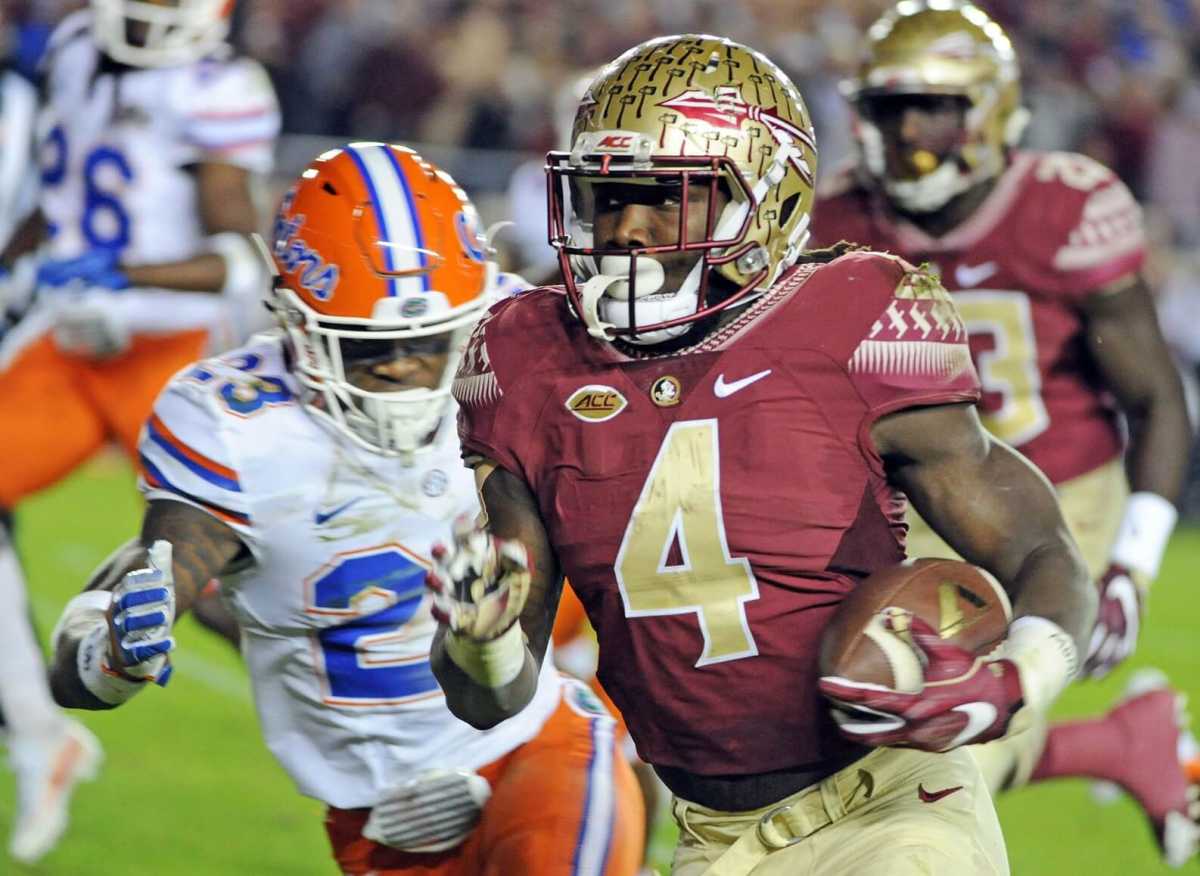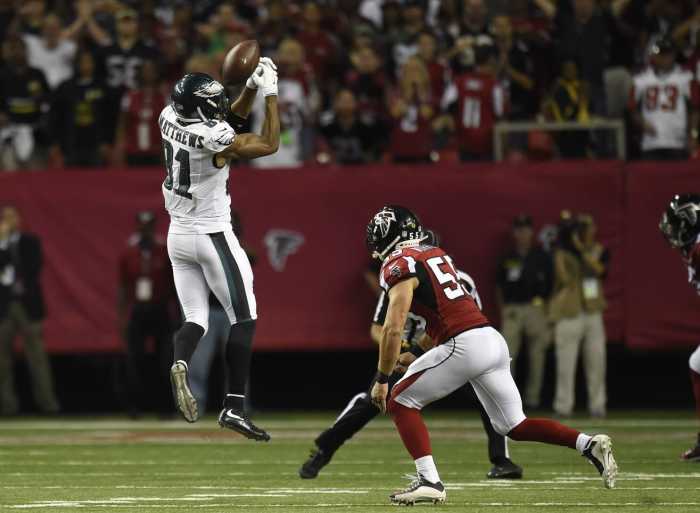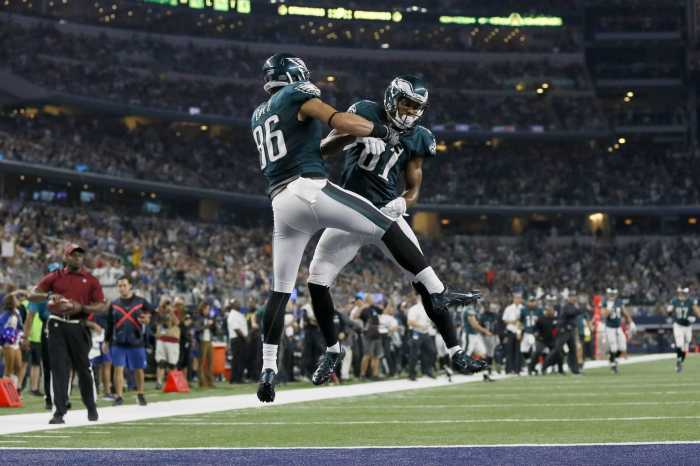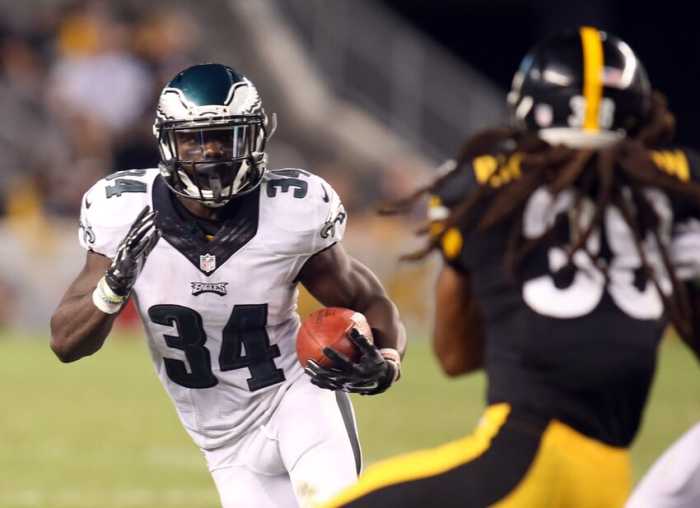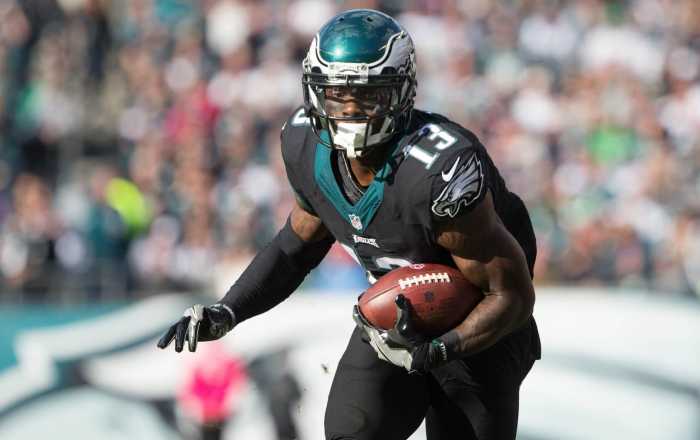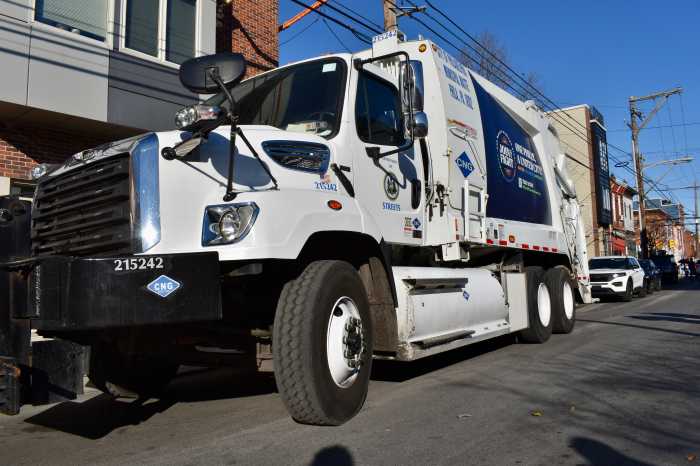The NFL Draft is rapidly approaching and for the Eagles, speculation over who they will take in the first round is riper than ever. From cornerbacks to wideouts, there have been a plethora of players linked with the number 14 pick..but the excitement has recently transitioned to the backfield. Christian McCaffrey and Dalvin Cook are just two running backs who have found themselves mocked to the Birds in recent weeks, with mid round backs and starting talents slipping through the cracks due to such a strong class being even more popular. But before any of that, the Eagles have more than a few questions to answer if they are to justify spending a pick on a running back.
Carson Wentz attempted 608 passes in his rookie season, while the Eagles backfield combined for a total of 381 carries. That does not scream consistency, nor does it scream balance. The only picture that it really does paint clearly is that the Eagles simply couldn’t figure out how to maximize the potential of such an elusive and dynamic unit.
In fact, the entire Eagles backfield struggled to move the chains. The team converted third downs on the ground just 45% of the time this year, 23% less than they did under Chip Kelly in 2015. The difference was that even though Kelly’s offense was flawed in numerous ways, with one being the misuse of DeMarco Murray, the direction remained the same. An effort by committee. An effort which Pederson aimed to replicate in 2016, with mixed success..and it’s this mixed success that leaves them at such a crossroads.
As it stands, the Eagles have five running backs on their roster:
Ryan Mathews:
Mathews ended last year with 661 yards and 8 touchdowns, which was more productive than his first year in the City of Brotherly Love. But coming off of a serious neck injury, the “injury-prone” label is more deadly than ever to the former Chargers running back. The Eagles have a flurry of talent in the backfield, but no real direction implemented. The team can’t part ways with the 29-year old until he officially returns from injury, giving them some breathing room to make a decision..but it isn’t an easy one.
Through a mix of injury battles and lack of direction, Ryan Mathews would find himself rushing for 56 yards against the Vikings one week, before carrying the ball just 4 times against the Cowboys, despite playing in 45% of Offensive snaps, the next. 2016 was a year of instability for the Eagles backfield..and the injury status of Mathews only contributed to that.
The problem is, that it would suit Mathews to take a pay cut and stay with the team for one more year. Such a scenario would give the Eagles a running back who in his final five games of 2016 rushed for 374 on a low-risk, high-reward deal. The problem would be, Mathews is not a long-term solution. He’s very much the keyholder in all of this. If the Eagles wish to pursue a committee approach, then keeping him around makes a lot of sense. But if it’s a lead back they seek, this is where the problems begin.
Darren Sproles:
The veteran running back has already stated his intentions to retire after next season, giving the Eagles one more year to utilize one of the most dynamic players in the NFL. Sproles showed that age played no factor last season, as he rushed for 438 yards and received for 427 more. But, like Mathews, Sproles is not a running back that the team can build around. In a committee effort, Sproles could mentor an extremely young corps and still carry much of the workload as he did in 2016, where he played in 45% of snaps. But with such a strong running back class, arguably the best of a generation, would it not make sense to source a replacement for Sproles now..even if he does ensure a redshirt year so to speak?
The versatility of Sproles opens up so much in the passing game, just as it did against the Pittsburgh where he received for 128 yards. There’s no doubting that as of right now, he’s still an incredibly elusive option in Pederson’s offense, especially with the new wide receiver signings of Alshon Jeffery and Torrey Smith.
But that luxury is available for just one more year..and if the Eagles ride Sproles for another 511 snaps, they could be left with a backfield just as inconsistent as they did one year ago. Such a season would also see a slight lean toward a committee effort..but what happens next? The Eagles need to decide just how prominent Sproles will be in Pederson’s offense before drafting a back, because so much of the shape rests on the shoulders of the little engine that could.
Wendell Smallwood:
Then, there’s the wildcard. Often overlooked when discussing the running back picture, Smallwood rushed for 312 yards and a score in his rookie year, before an injury cut his debut season short. The West Virginia product certainly flashed in that timespan but did he do enough to step up as a three-down back? It’s debatable. While his 4.1 yards per carry is moderately impressive, the Eagles would have far fewer questions to answer if Smallwood could mix his bursts of explosiveness with a touch of consistency and some increased ball security.
Whatever happens, it seems unlikely that the Eagles will part way with Smallwood after just one year. But if the team decide to draft Dalvin Cook or a player they believe to be a feature back, his role will remain marginalized. Although Smallwood exploded for big performances against Pittsburgh and Atlanta, he could never find the rhythm needed to sustain a spot at the top of the pecking order. If the team roll with a committee effort, then Smallwood has a chance of developing further and moving up the depth chart. Drafting a running back would leave his future an extremely tough puzzle to solve. Knowing that the Eagles would already have to move on from Mathews and potentially Sproles, Pederson’s regard of Smallwood could play a vital role in just how important the Eagles view the hole at running back.
Byron Marshall:
The former Oregon Duck may not have played a huge role in the Eagles 2016 rushing efforts, but in the few snaps he did play..he certainly raised a few eyebrows. In fact, the incredibly versatile back was one of the few players who showed signs of development in a single game, as detailed in this All-22.
Marshall possesses many of the qualities that make Darren Sproles so special. An undrafted rookie one year ago, he was able to cling to the Eagles practice squad, which resulted in his name being called when the injury bug began to bite. His future is a lot more difficult to predict because of the extremely low cap implications, but having shown the world just how dynamic he could become, the Eagles could well have a Sproles 2.0 in the making.
The problem with this, once again becomes what to do with Marshall if the team draft a running back. Someone like Christian McCaffrey brings the same traits to the table, but the only difference is that the Stanford rusher is far more decorated. If the team do draft a lead back, would they need to keep Marshall around, given the presence of Wendell Smallwood and Darren Sproles in 2017, not to mention the potential return of Ryan Mathews?
Terrell Watson:
One of the most inspiring stories of 2016 opened an exciting new chapter when Watson scored his first NFL touchdown in the Eagles season finale. Rushing for 28 yards and a touchdown, Watson showed the athleticism and heart that had lifted him through some incredibly dark times and opened a path to the NFL. Like Marshall, his future is uncertain..but the Eagles felt comfortable enough bringing him in mid-season and throwing him into a live game scenario. Watson will be competing hard for a spot in Training camp..and if there is a committee effort in place, he absolutely has a shot of earning a roster spot. But if the Eagles draft a running back to lead the corps, those chances take a huge hit.
If the Eagles were to pursue a lead running back in the draft, someone of Dalvin Cook’s nature for instance, the team would be left with an abundance of talent in the backfield..and an incredibly amount of dynamic ability. Before even contemplating drafting a lead back, the Eagles have to make corresponding moves and decide what kind of backfield they wish to build.
After such a dominating performance against a stern Defense against Pittsburgh, many were excited to see what the Eagles backfield would do next. That excitement turned into anxiety and that anxiety turned into a complete loss of hope. There was no greater sign of the Eagles failure to balance the Offense and the catastrophic effects it can have, than the dismantling handed to them by Cincinnati.
Throwing the ball 46 times, Carson Wentz had little help outside and even less behind him. It’s arguable that the wildly inconsistent backfield’s lack of production could be a byproduct of Lane Johnson’s absence, but the lead rusher in both of their last games rushed for under 50-yards.
The unit wasn’t completely ineffective in 2016. The Eagles still put up 1,813 total yards that was good enough to rank 11th in the league. The problem came with a failure to establish a consistent balance or utilize the many styles of back sat on the sideline during a live-game.
Drafting a running back without first addressing the aforementioned questions, could be setting the team up for similar problems as the regular season unfolds. Committee backfields can work in the NFL. Kansas City, New England, Seattle, Pittsburgh, and Tennessee are just a few of the teams who for one reason or another, have relied on a group charge at some stage in the last few years. It’s something Pederson is comfortable in, given his previous involvement with the Kansas City playcalling when Jamaal Charles was injured. Spencer Ware, Charcandrick West and Knile Davis all had huge years under Pederson’s tutelage in 2015.
Whether it’s Dalvin Cook, Christian McCaffery, Leonard Fournette, Donnel Pumphrey, or an undrafted rookie..the Eagles cannot afford to stifle their backfield any further through a neglect to view the bigger picture. It’s something that has been expressed numerous times by Howie Roseman..but it’s the running back position that will best represent just what the team’s new direction really embodies.
Mandatory Credit: Melina Vastola-USA TODAY Sports

